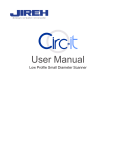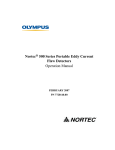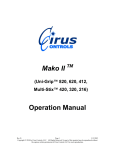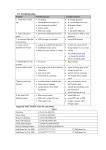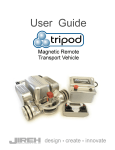Download to view PDF - Jireh Industries
Transcript
User Manual Manual Magnetic Scanner Safety Warnings / Precautions KEEP THIS MANUAL – DO NOT LOSE THIS MANUAL IS PART OF THE STIX AND MUST BE RETAINED FOR THE LIFE OF THE PRODUCT. PASS ON TO SUBSEQUENT OWNERS. Ensure any amendments are incorporated with this document. DANGER! The STIX is designed for a specific use. Using the STIX outside of its intended use could cause damage to the product. Read and understand this manual before using. WARNING! Can be harmful to pacemaker and ICD wearers. Stay at least 25 cm (10”) away. WARNING! Do NOT operate scanner in an explosive environment. Do NOT operate scanner in the presence of volatile substances. The WEEE symbol indicates that the product must not be disposed of as unsorted municipal waste, but should be collected separately. DISTRIBUTOR: MANUFACTURER: Jireh Industries Ltd. 53158 Range Road 224 Ardrossan, Alberta, Canada T8E 2K4 Phone: (780) 922-4534 Fax: (780) 922-5766 www.jireh-industries.com PAGE i of iv BG0089 Rev 01 Table of Contents 1.Introduction 1.1. 1 Product information 1.1.1. Intended use 1.1.2. Performance specifications 1.1.3. Operating environment 1.2. Definition of symbols 1.3.Hardware 1.3.1. Included tools 1.3.2. Optional tools 1.3.3. Maintenance 2. Configurations 2.1. 2.2. 2.3. 3 Two Probe Phased Array Four Probe Four Probe Cantilever 3.Operation 3.1. STIX setup on a scan surface 5 7 Wheel Block with Handle 4.1.1. Wheel Installation 4.1.2. Wheel Removal 4.1.3. Ratchet Lever 4.2. Frame Bar 4.3.Encoder 4.4. Pivot Buttons 4.5. Slip Joint Probe Holder 4.6. 3 3 4 5 4. Component Overview 4.1. 1 1 1 1 1 2 2 2 2 4.5.1. 4.5.2. 4.5.3. 4.5.4. Probe Holder Setup Probe Holder Adjustment Probe Holder Force Adjustment Slip Joint Probe Holder Left/Right Conversion 4.6.1. 4.6.2. 4.6.3. 4.6.4. 4.6.5. Probe Holder Setup Probe Holder Vertical Adjustment Probe Holder Transverse Adjustment Probe Holder Longitudinal Adjustment Probe Holder Left/Right Conversion Vertical Probe Holder PAGE ii of iv 7 7 8 8 9 9 9 10 10 12 12 14 16 16 17 18 19 20 4.7. Cable Management System 4.8. 4.9. Magnetic Wheel Kit Pre-Amp Bracket 4.7.1. Zipper Tube Dovetail Mount 4.7.2. Zipper Tube Setup 4.7.3. Clamp Setup 22 22 23 24 25 26 5. Troubleshooting 27 6. Spare Parts 28 6.1. STIX Kit Components 6.1.1. Encoder Connector Style 6.2.Accessories 6.2.1. Magnetic Wheel Kit 6.2.2. Pre-Amp Bracket 6.2.3. Zipper Tube 6.3. Probe Holders 6.4. Probe Holder Components 6.5. Variable Components 6.3.1. Slip Joint Probe Holder Parts 6.3.2. Vertical Probe Holder Parts 6.4.1. Probe Holder Arm Style 6.4.2. Holder Yoke Style 6.4.3. Pivot Button Style 6.5.1. Frame Bars 7. Limited Warranty 28 29 29 29 30 30 31 31 32 33 33 33 33 33 33 34 PAGE iii of iv BG0089 Rev 01 PAGE iv of iv 1. Introduction 1.1. Product information 1.1.1. Intended use The STIX is a manual magnetic scanner with trailing encoder and magnetic wheels. It is designed to translate phased array and TOFD probes around ferrous piping and vessels. 1.1.2. Performance specifications Minimum Maximum Pipe/Tube Range Outer Diameter 10.16 mm (4’’) Flat Pipe/Tube Range Inner Diameter 152.4 cm (60”) Flat Umbilical Length (Standard Kit) 5 m (16.4”) X Axis Encoder Resolution 9.06 counts/mm (230.0 counts/inch) 1.1.3. Operating environment The STIX is designed for use in industrial environments that are between -20°C and 50°C. 1.2. Definition of symbols Instructions to ‘look here’ or to ‘see this part’ Denotes movement. Instructing user to carry out action in a specified direction. Indicates alignment axis, can also indicate insertion or movement of parts. Alerts user that view has changed to a reverse angle. PAGE 1 of 35 BG0089 Rev 01 1.3. Hardware 1.3.1. Included tools Fig. 1 - 3 mm hex driver Fig. 2 - 3/8” wrench The 3 mm hex driver (Fig. 1) is sufficient for all typical operations and adjustments of the STIX. The 3/8” wrench (Fig. 2) is used to remove and install buttons on the probe holders. 1.3.2. Optional tools Some specialized adjustments require tools that are not included with this kit. Fig. 3 - 1.5 mm hex wrench Fig. 4 - 2 mm hex wrench Fig. 5 - 2.5 mm hex wrench Fig. 6 - 3 mm hex wrench 1.3.3. Maintenance General cleaning of components is important to keep your system working well. All components that have no wiring or cables are completely waterproof. Components can be washed with warm water, dish soap and a medium bristle brush. Before using the scanner, ensure all connectors are free of water and moisture. NOTE: All components with wiring, cables or electrical connections are splash proof. However, these components are NOT submersible. NOTE: Never use strong solvents or abrasive materials to clean your scanner components. PAGE 2 of 35 2. Configurations 2.1. Two Probe Phased Array Fig. 7 - Two probe phased array configuration 2.2. Four Probe Fig. 8 - Four probe configuration PAGE 3 of 35 BG0089 Rev 01 2.3. Four Probe Cantilever Fig. 100 - Four probe cantilever configuration PAGE 4 of 35 3. Operation 3.1. STIX setup on a scan surface 1. Mount the appropriate phased array and TOFD wedges to the probe holders (see Slip Joint Probe Holder on page 10). Fig. 9 - Mount wedges to probe holders Fig. 10 - Attach probe holders to configuration 2. Assemble the appropriate configuration (Fig. 10). Attach the slip joint probe holders to the frame bar where appropriate. 3. Ensure the brakes are locked on the wheel blocks (see Wheel Block with Handle on page 7). PAGE 5 of 35 BG0089 Rev 01 Fig. 11 - Place on scan surface 4. Place the configured STIX on the scan surface (Fig. 11). TIP: Use caution when placing equipment on the scan surface. The magnetized wheels can cause the assembly to lurch towards the metal suddenly. Fig. 12 - Prepared for scanning 5. Lower probe holders to the scan surface (see Probe Holder Adjustment on page 12), Release both brakes to begin scanning procedure. PAGE 6 of 35 4. Component Overview 4.1. Wheel Block with Handle The wheel block with handle provides stability and braking to the STIX system. Fig. 13 - Attach to a frame bar Fig. 14 - Tighten knob The ratchet lever located on the wheel block operates a brake (see Ratchet Lever on page 8). Four mounting points for cable management are located on the wheel block handle. (see Vertical Probe Holder on page 16) Attach a wheel block by loosening the black wing knob and sliding the wheel block’s dovetail nut onto a frame bar (Fig. 13). Tighten the black wing knob (Fig. 14). NOTE: Magnetic wheels may lose their magnetic properties if heated above 175°F (80° C). 4.1.1. Wheel Installation 1. Locate and position the threaded side of the magnetic wheel to the outside of the scanner. 2. Screw the magnetic wheel along the entire length of the axle. 3. Grip the magnetic wheel by hand and using the supplied 3mm hex driver (Fig. 1), tighten the magnetic wheel to the axle (Fig. 15). PAGE 7 of 35 Fig. 15 - Wheel installation BG0089 Rev 01 4.1.2. Wheel Removal 1. Tightly grip the magnetic wheel to be removed. Using the 3mm hex driver, loosen the magnetic wheel from the axle (Fig. 16). TIP: When the brake is engaged and the scanner is moved, this may loosen the wheels from the axle. Grip the magnetic wheel tightly and retighten to the axle with the 3mm hex driver. Fig. 16 - Wheel removal WARNING! MAGNETIC MATERIAL. The stabilizer wheel uses a magnetic wheel. People with pacemakers or ICD’s must stay at least 25 cm (10”) away. 4.1.3. Ratchet Lever The rachet levers lock the brakes of the STIX system. Occasionally, movement of the lever’s locking position is required. The lever placement can be adjusted by following these steps: Fig. 17 - Pull ratchet handle Fig. 18 - Rotate handle Fig. 19 - Tighten handle 1. Pull the ratchet lever away from the base of which it is connected (Fig. 17). 2. Continue to pull while rotating the lever in the appropriate direction (Fig. 18). 3. Release the lever and utilize the new tightening position (Fig. 19). PAGE 8 of 35 4.2. Frame Bar Frame bars (Fig. 20) are used to mount probe holders, probe positioning systems and other accessories (see Frame Bars on page 33). Frame bars are available in a variety of lengths. 4.3. Fig. 20 - Frame bar Encoder The spring loaded encoder wheel provides vertical travel while maintaining contact pressure to the scan surface. To install the encoder follow these steps: 2 1 Fig. 21 - Attach to frame bar Fig. 22 - Tighten knob Fig. 23 - Place on scan surface 1. Loosen the encoder’s dovetail jaw and mount to the frame bar (Fig. 21). 2. Tighten the encoder knob (Fig. 22). 3. Spring tension maintains encoder contact with the scan surface (Fig. 23). 4.4. Pivot Buttons Available in a variety of shapes and sizes fitting various wedge dimensions. Use the supplied 3/8” wrench (Fig. 2) to remove and install pivot buttons (Fig. 24). 2 1 Fig. 24 - Pivot buttons PAGE 9 of 35 BG0089 Rev 01 4.5. A B C D E F G H I Slip Joint Probe Holder Frame Bar Probe Holder Adjustment Knob A C B D Latch E Swing Arm Knob H Yoke Probe Holder Arm Adjustment Knob Probe Holder Arm F I Arm Clamp Screw Pivot Buttons G Fig. 25 - Slip Joint Probe Holder 4.5.1. Probe Holder Setup To mount a UT wedge in the probe holder, follow these steps: Fig. 26 - Attach to frame bar Fig. 27 - Adjust on frame bar 1. Rotate the probe holder adjustment knob and attach probe holder to a frame bar (Fig. 26). 2. Use the probe holder adjustment knob to position the probe holder along the frame bar (Fig. 27). Fig. 28 - Adjust swing arm PAGE 10 of 35 Fig. 29 - Place pivot buttons 3. Use swing arm knob to position the swing arm (Fig. 28). TIP: The swing arm is typically used to adjust TOFD center to center distance relative to the phased array probes on a four probe configuration (Fig. 28). 4. Using the supplied 3/8” wrench (Fig. 2), place the pivot buttons as required (Fig. 29). TIP: If narrow scanning footprint is required, use pivot button holes closest to the yoke. Wedge pivoting may be impeded when closer to the yoke. Fig. 30 - Adjust probe holder arms Fig. 31 - Place wedge 5. Loosen the probe holder arm adjustment knob (Fig. 30) and remove outer probe holder arm from yoke. 6. Adjust inner probe holder arm as required to best centre the probe on the yoke’s pivot axis (Fig. 30). TIP: The probe holder yoke can accommodate many different probe and wedge sizes of varying widths. It is best to centre the wedge with the yoke’s pivot axis to reduce wedge tipping when scanning. Position the inner probe holder arm accordingly with the centre of the yoke (Fig. 30). 7. Position the wedge on the inner probe holder arm (Fig. 31). 8. Slide outer probe holder arm along the yoke pinching the wedge in place. 9. Tighten probe holder arm adjustment knob (Fig. 32). Fig. 32 - Pinch wedge with arm PAGE 11 of 35 BG0089 Rev 01 4.5.2. Probe Holder Adjustment To adjust the probe holder, follow these steps: 6mm approx. Fig. 33 - Lift to Latched position Fig. 34 - Lower to scanning surface 1. Ensure probe holder is in latched, upper position (Fig. 33). If the probe holder is already latched, it will only move within the slip joint adjustment range and have no spring tension. 2. Push the probe holder yoke down toward inspection surface until the wedge is approximately 6 mm (¼”) above the inspection surface (Fig. 34). Fig. 35 - Lift and press latch button Fig. 36 - Spring loaded scan position 3. Lift probe slightly and press latch button (Fig. 35) to apply spring pressure to the wedge. 4. Gently lower probe holder and wedge to the scanning surface (Fig. 36). 4.5.3. Probe Holder Force Adjustment It is possible to adjust the tension of the probe holder spring. NOTE: To perform this operation the 2 mm hex wrench (Fig. 4) and 3 mm hex wrench (Fig. 6) is required. Light Medium Heavy 1 kg 2 lbs 2 kg 4 lbs 3 kg 6 lbs When configured correctly, these settings exert the indicated spring force on the Probe. PAGE 12 of 35 To adjust the probe holder’s force, follow these steps: NOTE: Do not perform this operation on scanning surface. Fig. 37 - Lift slightly and press Latch Fig. 38 - Unlatched position 1. Ensure the probe holder is in the upright latched position (Fig. 33). 2. Lift probe holder slightly and press the latch button (Fig. 37) to release the probe holder the full 45° degrees. 3. Insert the short arm of a 3 mm hex wrench into the 3 mm slot (Fig. 38). Fig. 39 - Insert hex wrenches Fig. 40 - Press 3 mm hex wrench down 4. Place the 2 mm hex wrench into the force adjustment screw (Fig. 39). 5. Lightly press the long arm of the 3 mm hex wrench down. Using the 2 mm hex wrench, loosen the force adjustment screw but do not remove it (Fig. 40). 6. Gently apply pressure on the long leg of the 3 mm hex wrench until the force adjustment marker lines up with the desired spring tension. While keeping the markers in line, tighten the force adjustment screw (Fig. 41). Heavy Medium Light Force Adj. Marker Fig. 41 - Choose desired tension PAGE 13 of 35 BG0089 Rev 01 4.5.4. Slip Joint Probe Holder Left/Right Conversion To reverse the probe holder, follow these steps: Fig. 42 - Unscrew yoke pivot screw Fig. 43 - Remove arms 1. Unscrew the yoke from the swing arm (Fig. 42). 2. Loosen the probe holder arm adjustment knob and arm clamp screw. Slide the arms from the yoke (Fig. 43). Fig. 44 - Flip yoke and reverse arms Fig. 45 - Attach arms and move buttons 3. Flip the yoke 180° and reverse the probe holder arms (Fig. 44). 4. Place the pivot buttons on the inside of the probe holder arms (Fig. 45) using a 3/8” wrench (Fig. 2). Slide the arms onto the yoke and tighten the probe holder arm adjustment knob and the arm clamp screw. PAGE 14 of 35 Fig. 46 - Position swing arm Fig. 47 - Install yoke to swing arm 5. Loosen the swing arm knob and slide the swing arm to the opposite end of the probe holder bracket (Fig. 46) or preferred position. Tighten swing arm knob. 6. Using the 3 mm hex driver, screw the yoke pivot screw into the opposite side of the probe holder swing arm (Fig. 47). Ensure the yoke is level to avoid issues with the plunger/set screw. Fig. 48 - Reversed probe holder PAGE 15 of 35 BG0089 Rev 01 4.6. Vertical Probe Holder A B C D E Latch F G H I Yoke B A Probe Holder Adjustment Knob C Vertical Adjustment Knob Pivot Buttons I C H Probe Holder Arms G F Probe Holder Arm Adjustment Knob D Transverse Adjustment Screw Frame Bar E Fig. 49 - Vertical probe holder 4.6.1. Probe Holder Setup To mount a UT wedge in the probe holder, follow these steps: Fig. 50 - Adjust on frame bar Fig. 51 - Vertical adjustment Fig. 52 - Place buttons 1. The probe holder adjustment knob allows the probe holder to be attached to a frame bar, as well as horizontal positioning on a frame bar (Fig. 50). 2. Vertical adjustment knob allows the vertical probe holder height adjustment (Fig. 51). 3. Position the pivot buttons where necessary. When a narrow scanning footprint is required, use the pivot button holes closet to the yoke (Fig. 52). TIP: Probe pivoting may be impeded when closer to the yoke. PAGE 16 of 35 Fig. 53 - Adjust inner arm Fig. 54 - Adjust outer arm Fig. 55 - Tighten arm knob 4. Position the wedge on the inner probe holder arm (Fig. 53). TIP: The probe holder yoke can accommodate many different probe and wedge sizes of varying widths. It is best to centre the wedge with the yoke’s pivot axis. This can reduce wedge tipping when scanning. Position the inner probe holder arm accordingly (Fig. 53) using the supplied 3 mm hex driver (Fig. 1). 5. Loosen the probe holder arm adjustment knob (Fig. 54) and slide the probe holder arm along the yoke pinching the wedge in place. 6. Tighten the probe holder arm adjustment knob (Fig. 55). 4.6.2. Probe Holder Vertical Adjustment To adjust the probe holder vertically, follow these steps: approx. 6mm Fig. 56 - Latch probe holder Fig. 57 - Lower toward scan surface 1. Ensure the probe holder is in the latched, upper position. Lift the probe holder until the latch is fully exposed and snaps out to lock (Fig. 56). PAGE 17 of 35 BG0089 Rev 01 2. Loosen the vertical adjustment knob and slide the probe holder down until the wedge is approximately 6 mm (¼”) above inspection surface (Fig. 57). 3. Tighten the vertical adjustment knob (Fig. 57). Fig. 58 - Press latch button Fig. 59 - Lower toward scan surface 4. Lift the yoke slightly and press the latch button (Fig. 58), then slowly lower towards scanning surface to apply spring pressure to the wedge (Fig. 59). TIP: If less spring force is desired, refer to step 2 and place the wedge approximately 20 mm (¾”) above inspection surface. 4.6.3. Probe Holder Transverse Adjustment To adjust the probe holder’s transverse angle, follow these steps: Fig. 60 - Loosen 3 mm screw Fig. 61 - Rotate and tighten Fig. 62 - Stop post locates 90° 1. Ensure the probe holder is in latched, upper position (Fig. 56). PAGE 18 of 35 2. Using the supplied 3 mm hex driver loosen the transverse adjustment screw (Fig. 60) and rotate the yoke about the vertical shaft achieving the desired angle. 3. Tighten the transverse adjustment screw (Fig. 61). To return the transverse adjustment to neutral (90°). The probe holder must be in the latched, upper position (Fig. 56). Rotate the yoke until the stop post contacts the base of the probe holder (Fig. 62). Then tighten the transverse adjustment screw. 4.6.4. Probe Holder Longitudinal Adjustment To adjust the probe holder’s vertical angle for longitudinal scanning, follow these steps: Fig. 63 - Loosen 3 mm screw Fig. 64 - Rotate to position Fig. 65 - Line up markers 1. Ensure the probe holder is in latched, upper position (Fig. 56). 2. Using the supplied 3 mm hex driver (Fig. 1), loosen the longitudinal adjustment screw (Fig. 63). 3. Rotate the main body of the probe holder until it is at the desired angle (Fig. 64). 4. Tighten the longitudinal adjustment screw (Fig. 64). To return the longitudinal adjustment to neutral (90°). Line up the longitudinal adjustment indicator markers (Fig. 65). PAGE 19 of 35 BG0089 Rev 01 4.6.5. Probe Holder Left/Right Conversion To reverse the probe holder, follow these steps: NOTE: To perform this operation the 1.5 mm hex wrench (Fig. 3) is required. Fig. 66 - Unscrew yoke pivot screw Fig. 67 - Remove probe holder arms 1. Ensure the probe holder is in latched, upper position (Fig. 56). 2. Using the supplied 3 mm hex driver (Fig. 1), unscrew the yoke pivot screw and remove yoke (Fig. 66). 3. Loosen the probe holder arm adjustment knob and the arm clamp screw. Slide the probe holder arms off the yoke (Fig. 67). Fig. 68 - Flip yoke and reverse arms Fig. 69 - Attach arms & move buttons 4. Flip the yoke 180° and reverse the probe holder arms (Fig. 68). 5. Place the pivot buttons on the inside of the probe holder arms (Fig. 69) using a 3/8” wrench (Fig. 2). PAGE 20 of 35 1. Fig. 70 - Screw yoke to opposite side Fig. 71 - Lower 90° stop post 6. Mount the yoke to the opposite side of the base using the supplied 3 mm hex driver (Fig. 70). TIP: Keep the yoke level with the base as to ensure no conflicts with the plunger/set screw attached to the yoke. 7. Locate the recessed 1.5 mm screw on the bottom of the probe holder. Unscrew the stop post without removing until it has cleared all obstructions (Fig. 71). Fig. 72 - Raise opposite 90° stop post Fig. 73 - Reversed probe holder 8. Raise the stop post on the opposite side until the side of the post clearly contacts the 90° stop point on the probe holder’s base (Fig. 72). PAGE 21 of 35 BG0089 Rev 01 4.7. Cable Management System Fig. 74 - Cable management 4.7.1. Zipper Tube Dovetail Mount Multiple dovetail mount locations are available on the wheel block handles. To attach a zipper tube for cable management, follow these steps: 1 2 Fig. 75 - Cable management PAGE 22 of 35 1. Loosen the knob on the zipper tube dovetail mount. Attach the mount onto the dovetail link (Fig. 75-1). 2. Once centred on the dovetail link, tighten the zipper tube’s knob (Fig. 75-2). 4.7.2. Zipper Tube Setup The zipper tube option is offered in a variety of lengths and provides a means of bundling and protecting cables and hoses that run to the scanner. Fig. 76 - Insert cables and hoses Fig. 77 - Zip up to close 1. Open the zipper tube. Begin at the tube’s dovetail mount and place the cabling in the tube (Fig. 76). 2. Follow the cable placement zipping the tube closed (Fig. 77). Fig. 78 - Zip opposite end Fig. 79 - Flexibility 3. Once the cable is placed the entire length of tube, bring the zipper from the tubes opposite end, meeting at any point in the middle (Fig. 78). 4. When necessary, the two zippers may be opened to allow any cables to exit the tube anywhere between the ends (Fig. 79). PAGE 23 of 35 BG0089 Rev 01 4.7.3. Clamp Setup If the tube becomes disconnected from the zipper tube dovetail mount, follow these instructions to re-attach the tube and dovetail mount. 1. Loosen the clamp screw using the supplied 3 mm hex driver. 2. Slide the clamp around the tube first and then slide the tube around the outside of the zipper tube dovetail mount (Fig. 80). Align the zipper opening and the zipper tube dovetail mount opening. 3. Slide the clamp over the tube and zipper tube dovetail mount pinching the tube in between (Fig. 81). Fig. 80 - Slide tube around mount Fig. 81 - Slide clamp onto mount 4. Tighten the clamp screw (Fig. 82). Fig. 82 - Tighten clamp screw PAGE 24 of 35 4.8. Magnetic Wheel Kit Two sets of the magnetic wheels can be used with the STIX, thus doubling the magnetic force. NOTE: Magnetic wheels may lose their magnetic properties if heated above 175°F (80° C). To install additional magnetic wheels, follow these steps: Fig. 83 - Screw on additional magnetic wheel Fig. 84 - Tighten with 3mm hex driver 1. Ensure the four existing wheels are tight (see Wheel Installation on page 7) 2. On the magnetic wheel to be attached, locate the threaded side of the magnetic wheel, orient the threaded side towards the scanner. 3. By hand, grip the wheel already attached to the wheel block. Overcome the magnetic resistance to screw the additional wheel to the axle of the wheel block (Fig. 83). 4. Steadily hold the newly added magnetic wheel, insert the 3 mm hex driver into the axle and tighten the additional wheel (Fig. 84). TIP: To remove additional wheels, reverse these steps. WARNING! MAGNETIC MATERIAL. The magnetic wheel kit produce a magnetic field which may cause failure or permanent damage to items such as watches, memory devices, CRT monitors, medical devices or other electronics. People with pacemakers or ICD’s must stay at least 25 cm (10”) away. PAGE 25 of 35 BG0089 Rev 01 4.9. Pre-Amp Bracket The pre-amp bracket mounts to any dovetail groove to hold a pre-amp. Compatible with most standard preamps, use the adjustable screw mounting channel on the bottom of the bracket to attach a pre-amp. The pre-amp bracket may also be ordered with velcro straps which are used to hold the pre-amp. 1 Fig. 85 - Insert velcro straps 3 2 Fig. 86 - Place pre-amp and wrap velcro PAGE 26 of 35 Fig. 87 - Mount bracket on a frame bar 5. Troubleshooting Problem 1. Encoder not functioning. Possible Cause Solution Instrument not properly setup. Refer to instrument’s documentation regarding proper setup. Issue with encoder. Contact Jireh Industries for repair (see Jireh Industries Ltd. on page i). 2. Insufficient Scanner not set probe contact. properly. Reconfigure the scanner as per instructions 3. Magnetic wheels become loose. Ensure the brakes are unlocked when using the scanner (see Wheel Block with Handle on (see Probe Holder Adjustment on page 12). Brakes are engaged. page 7). PAGE 27 of 35 BG0089 Rev 01 6. Spare Parts To order accessories or replacement parts for your STIX system. (contact Jireh Industries Ltd. on page i) NOTE: These drawings are for parts order. This is not a list of kit contents. 6.1. STIX Kit Components 11 12 10 7 9 6 8 5 4 3 BOM ID 1 2 3 4 5 6 7 8 2 Fig. 88 - STIX kit components Part # BGA005 PHG014 EA414 EA470 BGS058 BTS031 BTS018 BT0172 Description Stix Case Probe Holder Spare Parts 3mm Hex Driver 3/8’’ Wrench Wheel Block with Handle Magnetic Wheel Brake Handle PAGE 28 of 35 Dovetail Nut 1 2 BOM ID 1 2 3 4 5 6 7 8 9 10 11 12 Part # BGA005 PHG014 EA414 EA470 BGS058 BTS031 BTS018 BT0172 EA079 BG0038-40 CMG007 BGS053-X Description Stix Case Probe Holder Spare Parts 3mm Hex Driver 3/8’’ Wrench Wheel Block with Handle Magnetic Wheel Brake Handle Dovetail Nut Knob Frame Bar, 40cm (see 6.5.1) Irrigation Kit, 2-4 Probe Encoder (see 6.1.1.) Fig. 89 - STIX kit components (cont.) 6.1.1. Encoder Connector Style Connector Type Company/Instrument Connector Type Company/Instrument B Olympus - OmniScan MX / Zetec - ZIRCON, TOPAZ G Sonotron - Isonic C Olympus - Focus LT / Zetec Z-Scan M GE - USM Vision D Olympus - OmniScan MX2, OmniScan SX U Sonatest - VEO, PRISMA F TD - Focus Scan, Handy Scan, Pocket Scan V Pragma PAUT 16/128, PragmaLite Fig. 90 - Encoder style NOTE: Additional encoder connector styles available. (contact Jireh Industries Ltd. on page i) 6.2. Accessories 6.2.1. Magnetic Wheel Kit BOM ID Part # 1 BTG014 Description Magnetic Wheel Kit Fig. 91 - Magnetic wheel kit PAGE 29 of 35 BG0089 Rev 01 6.2.2. Pre-Amp Bracket BOM ID Part # 1 CES029 2 CES029-V Description Pre-Amp Bracket Pre-Amp Bracket with Velcro Fig. 92 - Pre-amp bracket 6.2.3. Zipper Tube BOM ID Part # Description 1 CES044-5 Zipper Tube (5 m length) 1 CES044-10 Zipper Tube (10 m length) Fig. 93 - Zipper tube PAGE 30 of 35 6.3. Probe Holders 6.3.1. Slip Joint Probe Holder Parts 3 1 2 4 5 6 7 8 BOM ID 1 2 3 4 5 6 7 8 Part # PHS022 MD050-010 PH0104 PH0100 PH0082 SEE 6.4.2 SEE 6.4.1 PH0011-X Description Slip Joint Probe Holder Subassembly Arm Clamp Screw, SHCS, M4x0.7 X 10mm, SST Swing Arm Knob Swing Arm Probe Holder Arm Adjustment Knob Yoke Style Arm Style Pivot Button Style, (See 6.4.3) Fig. 94 - Slip joint probe holder parts PAGE 31 of 35 BG0089 Rev 01 6.3.2. Vertical Probe Holder Parts 1 6 2 5 4 3 BOM ID 1 2 3 4 5 6 Part # PHS028 PH0082 SEE 6.4.1 PH0011-X SEE 6.4.1 MD050-010 Description Vertical Probe Holder Subassembly Probe Holder Arm Adjustment Knob Arm Style Pivot Button Style, (See 6.4.3) Yoke Style Arm Clamp Screw, SHCS, M4x0.7 X 10mm, SST Fig. 95 - Vertical probe holder PAGE 32 of 35 6.4. Probe Holder Components 6.4.1. Probe Holder Arm Style Arm Style Part # A Standard PH0090 C Long E G Arm Style Part Number B Short PH0089 PH0099 D Standard, Drop PH0093 Short, Drop PH0092 F Long, Drop PH0094 Standard, Extra-Drop PH0096 H Short, Extra-Drop PH0095 Fig. 96 - Probe holder arm selection 6.4.2. Holder Yoke Style Yoke Style S Standard Part # Length Yoke Style W PHS017 6.27cm (2.470”) Wide Part # Length PHS027 7.78cm (3.064”) Fig. 97 - Probe holder yoke selection 6.4.3. Pivot Button Style Pivot Hole Size Wedge Type 01 8.0mm (0.315”) Olympus PA 03 2.7mm (0.106”) 06 08 Pivot Hole Size Wedge Type 02 5.0mm (0.197”) Olympus TOFD Sonatest DAAH PA 04 9.5mm (0.375”) - 3.0mm (0.118”) - 07 2.3mm (0.090”) - Conical Head - 09 5mm (0.197”) Internal Zetec PA/TOFD Fig. 98 - Probe holder button selection NOTE: Additional probe holder pivot button types available. (contact Jireh Industries Ltd. on page i) 6.5. Variable Components 6.5.1. Frame Bars Part # Length Part # Length BG0038-05 5cm (1.969”) BG0038-10 10cm (3.937”) BG0038-15 15cm (5.906”) BG0038-20 20cm (7.874”) BG0038-25 25cm (9.843”) BG0038-30 30cm (11.811”) BG0038-35 35cm (13.780”) BG0038-40 40cm (15.748”) BG0038-45 45cm (17.717”) BG0038-50 50cm (19.685”) BG0038-55 55cm (21.654”) Fig. 99 - Frame bar selection PAGE 33 of 35 BG0089 Rev 01 7. Limited Warranty WARRANTY COVERAGE Jireh Industries warranty obligations are limited to the terms set forth below: Jireh Industries Ltd. (“Jireh”) warrants this hardware product against defects in materials and workmanship for a period of THREE (3) YEARS from the original date of purchase. If a defect exists, at its option Jireh will (1) repair the product at no charge, using new or refurbished replacement parts, (2) exchange the product with a product that is new or which has been manufactured from new or serviceable used parts and is at least functionally equivalent to the original product, or (3) refund the purchase price of the product. A replacement product/part assumes the remaining warranty of the original product or ninety (90) days from the date of replacement or repair, whichever provides longer coverage for you. When a product or part is exchanged, any replacement item becomes your property and the replaced item becomes Jireh’s property. When a refund is given, your product becomes Jireh’s property. OBTAINING WARRANTY SERVICE To utilize Jireh’s warranty service you must ship the product, at your expense, to and from Jireh Industries. Before you deliver your product for warranty service you must phone Jireh and obtain an RMA number. This number will be used to process and track your product. Jireh is not responsible for any damage incurred during transit. EXCLUSIONS AND LIMITATIONS This Limited Warranty applies only to hardware products manufactured by or for Jireh Industries. This warranty does not apply: (a) to damage caused by accident, abuse, misuse, misapplication, or non-Jireh products; (b) to damage caused by service (including upgrades and expansions) performed by anyone who is not an Jireh Authorized Service Provider; (c) to a product or a part that has been modified without the written permission of Jireh. Jireh Industries Ltd. 53158 Range Rd 224 Ardrossan AB T8E 2K4 Canada PH 780-922-4534 Fx 780-922-5766 www.jireh-industries.com PAGE 34 of 35 All brands are trademarks or registered trademarks of their respective owners and third party entities. Changes or modifications to this unit or accessories, not expressly approved by the party responsible for compliance could void the user’s authority to operate the equipment. All specifications are subject to change without notice. © 2014 Jireh Industries Ltd. PAGE 35 of 35 BG0089 Rev 01 Jireh Industries Ltd. 53158 Range Road 224 Ardrossan, Alberta Canada T8E 2k4 780-922-4534 jireh-industries.com










































